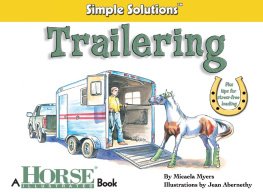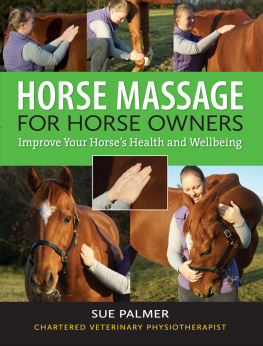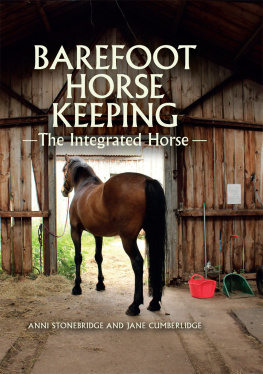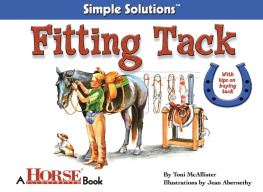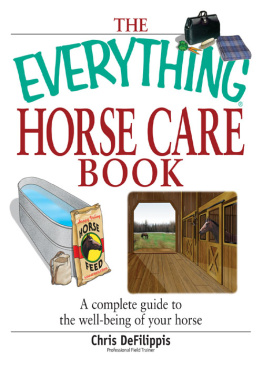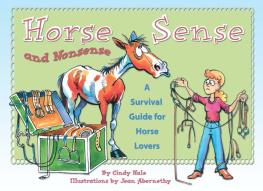Karla Austin, Director of Operations & Product Development
Nick Clemente, Special Consultant
Barbara Kimmel, Editor in Chief
Jessica Knott, Production Supervisor
Amy Stirnkorb, Designer
The horses in this book are referred to as she and he in alternating chapters unless their sexes are apparent from the activity discussed.
Copyright 2007 by I-5 Press
Illustrations 2007 by Jean Abernethy
All rights reserved. No part of this book may be reproduced, stored in a retrieval system, or transmitted in any form or by any means, electronic, mechanical, photocopying, recording, or otherwise, without the prior written permission of I-5 Press, except for the inclusion of brief quotations in an acknowledged review.
Library of Congress Cataloging-in-Publication Data
Myers, Micaela, 1974
Trailering / by Micaela Myers ; illustrations by Jean Abernethy.
p. cm. (Horse illustrated simple solutions)
ISBN 978-1-933958-06-4
eISBN: 9781620080863
1. Horse trailers. I. Title.
SF285.385.M94 2007
636.1083dc22
2007012755
I-5 Press
A Division of I-5 Publishing, LLC
3 Burroughs
Irvine, California 92618
Printed and bound in Singapore
16 15 14 13 12 11 10 09 08 07 1 2 3 4 5 6 7 8 9 10
CONTENTS

Matching Your Truck and Trailer
F or the majority of horse owners, the number one concern in trailering is how to get the horse in the trailer. But discussing how to load your horse before making sure the trailer is safe for her puts the cart before the horseor, rather, the horse before the trailer! A truck or an SUV plus a hitch does not necessarily equal a safe rig. If the tow vehicle or the hitch that connects vehicle and trailer is not rated to pull the load youre hauling, youre on a one-way road to disaster. So do your homework ahead of time, and make sure your truck, trailer, hitch, and horses are all a proper match.
The Trailer and Tow Vehicle
Before you bring your horse anywhere near your trailer, do some research and some basic calculations to be sure that your tow vehicle and trailer will not be overloaded and that your fully loaded (think passengers and gear) truck or SUV is rated to pull the weight of your fully loaded horse trailer. First, find the weight and loading information given by the manufacturers of your tow vehicle and trailer. This information should be listed on a label attached to the vehicle itself (usually in the drivers doorpost) or in the owners manual.
Look for two figures: the gross vehicle weight rating (GVWR) and the vehicles net weight, or base curb weight. The GVWR is the maximum weight that truck or trailer is designed to carry: the weight of the vehicle itself plus the hitch and kingpin, passengers, fluids, and cargo. The net, or base curb, weight measures only the standard vehicle with a full fuel tank. Subtract the net weight of each vehicle from its GVWR to find the total additional weight you may safely load into it.
Next, find your tow vehicles tow rating, the maximum weight it can safely pull. To determine whether your fully loaded trailer is too much for your tow vehicle to handle, add the weight of your horses and gear to the net weight of the trailer. This is the trailers gross vehicle weight (GVW). If the GVW is under both your tow vehicles tow rating and your trailers GVWR, you should be OK. Many vehicle manufacturers also provide additional towing information, such as the kingpin load (see The Trailer and Hitch) and how much rear gross axle weight the truck or SUV can handle, to help you determine whether your rig falls within safe limits.
If you arent buying a new trailer and you do not have your trailers weight information, you can weigh the trailer at a drive-on public scale. The weight information is critical. If you try to haul a load heavier than the weight your tow vehicle is rated for, youll have trouble accelerating and stopping, youll wear out your tow vehicle quickly, and you could cause a serious accident, so dont take any chances.
The Trailer and Hitch
There are two basic types of trailer: tag-along and gooseneck. Tag-along trailers are hitched behind the tow vehicle; gooseneck trailers are hitched inside the truck bed. Many trucks and SUVs come equipped with hitches, but that doesnt mean the components of the hitch are rated for the load you plan to haul. All hitch components, including the ball and the slide-in ball mount, must be the correct size and must be rated to pull the fully loaded weight of your trailer.

Gooseneck Trailer

Tag-along Trailer
Tag-along trailers (also called bumper pull trailers) require a professionally installed hitch, rated Class III or higher, attached to the frame of the vehicle. Although tag-along trailers are sometimes called bumper pull, never pull a tag-along by connecting it directly to your bumper; always use a hitch. Hitches have two weight ratingsone for the weight the hitch can bear without additional support, and a higher figure for the weight it can handle if it is equipped with weight distribution bars. Weight distribution bars are add-ons that distribute the weight of the trailer to all axels of the tow vehicle, often improving handling as well as stability. Check the hitch weight ratings to determine whether you need to purchase weight distribution bars. If so, youll probably want to have them professionally installed.


Gooseneck trailers feature a ball hitch mounted in the bed of the pickup truck. The ball component in the truck bed fits into the coupler component on the overlapping section of the trailer. This hitch also must be professionally installed and rated for the load you plan to haul. The kingpin load listed on the weight distribution label or in the owners manual is the amount of weight that can be placed on the hitch.
Whether you pull a tag-along or a gooseneck, check that you have the exact size ball you need for your coupler. A difference of even a fraction of an inch could mean your trailer wont attach snugly or could bounce off. And when your trailer is attached to your tow vehicle, make sure it is perfectly level at all times. For tag-along trailers, slide-in ball mounts can be purchased with varying drops (that can also be turned upside down into lifts) to make your trailer attach level. A trailer that tips forward or back puts stress on the hitch, forces your horse to work harder to keep her balance, causes uneven tire wear, and makes the ride bumpier and more dangerous.
Choosing a Trailer
I f you dont already have a trailer and wish to purchase one, be an informed buyer. Horse trailers come in a wide variety of sizes, materials, and styles with a seemingly endless choice of features. With a little preparation, you can narrow your search for a trailer that fits your needs and budget and makes the hauling experience safe and comfortable for you and your horse. Here are a few key points to consider:
Next page
